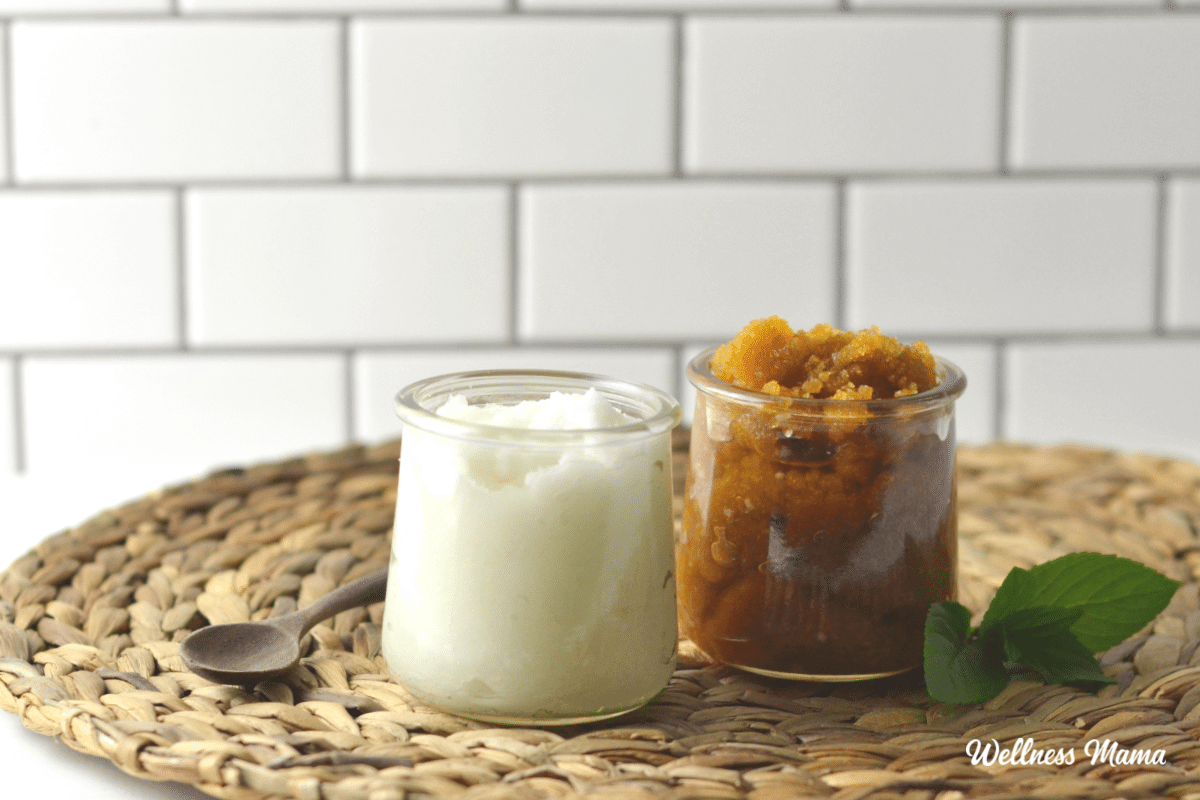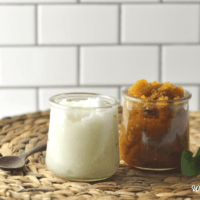As a busy mom, there are some days when I live off of dry shampoo and coffee. Over time though, hair care products (like dry shampoo) can cause a buildup on the scalp. For those with a flaky scalp, oily scalp, or even if the scalp just needs a deep clean, a DIY scalp scrub can be the solution.
What is a Scalp Scrub?
Body scrubs, and even lip scrubs, can be a regular part of skin routines to help remove dead skin cells and other impurities. A scalp scrub basically does the same thing but for your scalp. While a healthy shampoo focuses on cleansing and strengthening for healthy hair, scalp scrubs treat your scalp to a spa day.
A scrub can help with itchy scalps, excess oil, and stimulate circulation to help improve hair growth.
There are some good pre-made options, but like any skincare product, there are a lot of not so good scalp scrubs. It might be easy to grab a scrub from Ulta or Sephora, but these often have fragrances, parabens, and other potentially irritating chemicals. A DIY version is non-toxic, cheaper, and completely customizable to your preferences.
Who Should Use a Scalp Scrub?
Not everyone benefits from certain scalp treatments. Some scalp scrubs use salt and sugar granules which can be harsher on sensitive skin. People with dry hair, thick, curly hair, or more textured hair types also have special considerations. Scalp scrubs can damage this type of hair and are more suited for oily scalps, thin, or normal hair.
Best Scalp Scrubs for Sensitive or Dry Scalps
Almost everyone can benefit from some gentle scalp exfoliation though, so if you have thicker, more textured hair don’t rule it out just yet! Chemical exfoliants, like salicylic acid, hyaluronic acid, and hydroxy acids (like AHA), are commonly used. These work by loosening the bonds of dead skin cells so they can be washed off.
Salicylic acid is naturally found in certain foods like tomatoes and berries, and herbs like white willow bark. It can be irritating to more sensitive skin when used in large amounts. For reference, raspberries are a high salicylate food and they only have about .0004% salicylic acid. Face washes on the other hand can have around a 2% concentration.
Hyaluronic acid and AHA are gentler options for an exfoliating scalp scrub. Fermented foods, like sauerkraut, pickles, and yogurt are naturally high in AHA. While you probably don’t want to rub pickle juice on your hair follicles, yogurt can be a good deep cleansing option.
If your scalp feels dry, then a hydrating scalp mask with ingredients like yogurt, aloe vera, and avocado is a better option.
Scalp Scrub Ingredients
There are so many different options here it can seem overwhelming. I’m going to break down some of the top scrub ingredients and how they benefit the scalp. You can mix and match from this list, or follow one of the recipes below. Basically, you want an exfoliant (salt, sugar, or yogurt) and oil to start with. Then you can add on extra moisturizing and nourishing ingredients (like avocado, honey, or molasses).
- Salt or Sugar – Finely ground sea salt or Himalayan salt will work to exfoliate the scalp. Finely ground sugar is better for more sensitive skin because it isn’t quite as harsh.
- Yogurt – Naturally high in exfoliating AHA, yogurt boasts probiotics and skin softening abilities. This can be used with salt or sugar or as a gentle stand-alone exfoliant. Choose one with no added sugar or flavors. Homemade yogurt with a 24-hour ferment time is the best option since it has more AHA and less sugar.
- Raw honey – A natural humectant and moisturizer. Raw honey is also anti-microbial, anti-fungal, and clarifying for the skin.
- Coconut oil – Moisturizing and helps hold the scrub together. Coconut oil is especially good for dandruff and irritated skin. Some find it can clog pores, which shouldn’t be an issue if you’re using shampoo afterward.
- Avocado oil – I use this as part of a hair mask at night to help with hair growth and thickness. It can also help with psoriasis, dry skin, and repairs and softens skin.
- Sweet almond oil – A lightweight oil that’s an all around good moisturizer. It’s anti-inflammatory and high in the antioxidant vitamin E.
- Jojoba oil – Technically a wax, jojoba oil closely mimics skin’s sebum. It’s moisturizing, antifungal, antibacterial, anti-inflammatory, and more.
- Fresh avocado – Mashed avocado has many of the same benefits as avocado oil. It’s moisturizing and restoring to the scalp.
- Apple cider vinegar – Helps with dandruff and yeast overgrowth. Too much can be irritating to more sensitive skin though.
- Molasses – I love using molasses as a hair mask. It’s high in antioxidants and a good source of minerals for the scalp.
Scalp Scrub with Essential Oils
Now that we’ve whipped up a scrub, let’s add some essential oils! Not only do they smell good (most of the time), but they really benefit the skin and scalp. A lot of DIY scalp scrubs recommend peppermint essential oil, but it can actually be irritating to the skin. If you do opt for peppermint, make sure it’s diluted well and you don’t get it in your eyes! Essential oils should never go in the eyes, but some (like peppermint) burn more than others.
Here are some essential oils that work well in a scalp scrub:
- Rosemary – Good for dull skin, and dandruff, and stimulates circulation.
- Tea tree oil – Helps with oily or inflamed skin and dandruff.
- Cedarwood – Good for oily skin and scalp seborrhea.
- Clary sage – Helps with excess sebum, inflamed skin, and dandruff.
- Chamomile – Soothes and calms damaged or sensitive skin.
- Helichrysum – Cell regenerative and good for irritated skin.
- Lavender – Soothes damaged skin and is anti-inflammatory.
- Patchouli – For dandruff and inflamed skin.
- Laurel – Helps with oily skin and dandruff.
DIY Scalp Scrub
Equipment
Materials
For Sensitive Skin
- ½ cup yogurt
- ¼ cup organic white sugar
- 1 TBSP raw honey
- 1 TBSP avocado oil
- 15 drops essential oils optional
For Dandruff and Flakes
- ¾ cup salt finely ground
- ¼ cup coconut oil
- 1 TBSP apple cider vinegar
- 1 TBSP avocado oil jojoba, or sweet almond oil
- 20 drops essential oils optional
For Product Buildup and Cleansing
- ¾ cup salt or sugar finely ground
- 1 TBSP molasses
- 3 TBSP avocado oil
- 2 TBSP coconut oil
- 1 tsp jojoba oil
- 20 drops essential oils optional
Instructions
- Combine all of the ingredients for your chosen scalp scrub recipe together.
- Mix until smooth and use immediately.
Notes
How to Use a Scalp Scrub
Dermatologists in general recommend using a scalp scrub at most 2-3 times a week for a healthy scalp. Most people do well with just once a week though. It all depends on your scalp’s health, if it needs to detox, and your hair type. If your scalp isn’t very oily, you have coarse, thick hair, or otherwise don’t get much scalp build-up, then twice a month should be enough.
To apply, gently massage the scrub into the scalp, parting the hair and working in sections.
Use the scalp scrub before shampooing as usual. You may not need conditioner on the scalp since the scrub is so moisturizing. Instead, focus your conditioner on the ends of your hair as needed.
Want to Buy It?
If you don’t have time to DIY, here are some healthier scalp scrub options.
- Innersense True Enlightenment Scalp Scrub
- SHEA MOISTURE African Black Soap Bamboo Charcoal Scalp Scrub
- AyurVita Maka Extract Scalp Scrub & Cleanser
- Apple Biotic Probiotic Scalp and Body Scrub
This article was medically reviewed by Jessica Meyers, MPAP, PA-C, RH(AHG), who specializes in herbal protocols and functional medicine. You can also find Jessica on Instagram. As always, this is not personal medical advice and we recommend that you talk with your doctor.
What ingredients will you choose in your scalp scrub? Leave a comment and let us know!



Leave a Reply